BPA - Bisphenol A - possible effects during fetal development or on newborns
Bisphenol A, better known as BPA, is emerging as a possible toxin – especially during fetal development or for newborns, as studies over the past several years are connecting BPA levels to various health problems.
OPDD offers the following reports and data, listed in reverse chronological order with the most recent first, to help you make informed decisions regarding the plastic items that you buy and use.
Below this recycling guide, we have created a picture chart of items that have been reported safe from BPA and those containing BPA. But rather than depend upon a visual chart when you buy plastic products, it is wiser to use this simple recycling guide to help you choose the safer plastics:
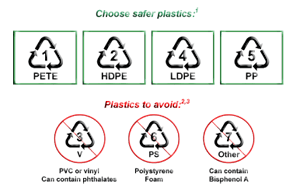
Here is a handy plastics chart for your reference...
Items with the numbers 1, 2, 4 and 5 are considered the safest plastics for use with foods or around infants and children.
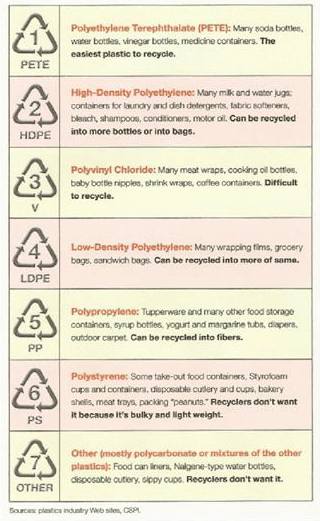
It is best to avoid plastics with the recycling numbers 3, 6 or 7. These are also the plastics which are difficult to recycle.
Here is a sample visual guide to BPA-free items and those with BPA content, according to the online reports and studies listed further down this page...
So how do you protect yourself from the potential hazards of BPA?
For your safety, download this pdf file called Check the Kind of Plastics You Use – by the Pediatric Environmental Health Specialty Units (PEHSU) of the Association of Occupational and Environmental Clinics (AOEC):
- Avoid plastics with symbol # 3 (PVC or polyvinyl, which contains phthalates), symbol # 6 (PS or polystyrene foam or Styrofoam) and symbol # 7 (other, including BPA).
- Do not microwave food/beverages in plastic
- Do not microwave or heat plastic cling wraps
- Do not place plastics in the dishwasher
- If using hard polycarbonate plastics (water bottles/baby bottles/sippy cups), do not use for warm/hot liquids
- Use safe alternatives such as glass or polyethylene plastic (symbol #1)
- Avoid canned foods when possible (BPA may be used in can linings)
- Look for labels on products that say “phthalate-free” or “BPA-free”
BELOW ARE LINKS TO ARTICLES THAT HAVE BEEN PRINTED ABOUT BPA OVER THE PAST SEVERAL YEARS, in reverse chronological order...
Chemical BPA in workers linked to problems in Chinese workers...
Associated Press, November 11, 2009, By Malcolm Ritter, AP Science Writer
NEW YORK – Male factory workers in China who got very high doses of a chemical that's been widely used in hard plastic bottles had high rates of sexual problems, researchers reported Wednesday.
Heavy exposure to BPA, or bisphenol A, on the job was linked to impotence and lower sexual desire and satisfaction, according to the study, which adds to concerns about BPA's effects on most consumers.
Click here for the rest of the story...
Estrogen contamination in bottled water ‘just the tip of the iceberg,’ say scientists...
BattlingForHealth.com, March 27, 2009, by Kate Melville
The notion that bottled mineral water is clean and without contamination is being challenged by new research that has identified significant levels of estrogen in bottled water that appears to have leached from the plastic bottle. Martin Wagner and Jörg Oehlmann, from the Department of Aquatic Ecotoxicology at the Goethe University in Frankfurt, Germany, make no bones about it, declaring that plastic mineral water bottles contaminate drinking water with xenoestrogens.
Click here to read rest of the story...
Parents and scientists pressure retailers to phase out baby products with BPA...
Northwestern University, Medill School of Journalism, Dec. 02, 2008, by Julia Dilday
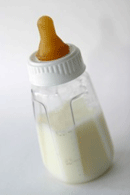 Concerned parents and consumers across the U.S. have successfully pushed companies to phase out baby bottles and other products containing bisphenol A (BPA), a hardening ingredient in many plastics.
Concerned parents and consumers across the U.S. have successfully pushed companies to phase out baby bottles and other products containing bisphenol A (BPA), a hardening ingredient in many plastics.
Toys “R” Us and Babies “R” Us are phasing out baby feeding products containing BPA by the end of 2008, the chain confirmed this week.
Baby bottles at Target will be completely BPA-free by the end of January. Wal-mart is following suit and a company spokesman stated that all baby bottles will be BPA-free by mid-year in 2009.
Click here to read rest of the story...
Know Your Carcinogens: the lastest on BPA...
BattlingForHealth.com, November 18, 2008 by Rachel
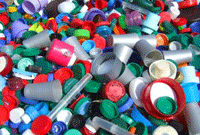 Ever since it hit the news late last year, bisphenol A (BPA) is getting more and more notorious. The latest development in the BPA story is this – researchers at the University of Cincinnati reported that exposure to BPA may actually reduce the effectiveness of chemotherapy treatments among cancer patients.
Ever since it hit the news late last year, bisphenol A (BPA) is getting more and more notorious. The latest development in the BPA story is this – researchers at the University of Cincinnati reported that exposure to BPA may actually reduce the effectiveness of chemotherapy treatments among cancer patients.
Yet, plastic manufacturers all over are still using it in their polymerization process. And food manufacturers are using plastics with BPA in their packaging.
Click here for the rest of the story...
According to a report of the National Toxicology Program (NTP) of the U.S. National Institutes of Health (NIH)
"BPA is a high production volume chemical used primarily in theproduction of polycarbonate plastics and epoxy resins... The primary source of exposure to BPA for most people is through the diet... BPA in food and beverages accounts for the majority of daily human exposure."
Click here for full report...
Tests find chemical after normal heating of 'microwave safe' plastics...
JournalSentinel.com, By Susanne Rust and Meg Kissinger of the Journal Sentinel, Posted: Nov. 15, 2008
Products marketed for infants or billed as "microwave safe" release toxic doses of the chemical bisphenol A when heated, an analysis by the Journal Sentinel has found. The newspaper had the containers of 10 items tested in a lab - products that were heated in a microwave or conventional oven. Bisphenol A, or BPA, was found to be leaching from all of them.
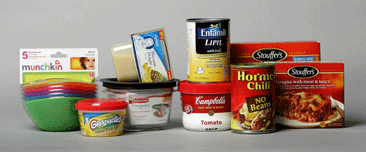
The amounts detected were at levels that scientists have found cause neurological and developmental damage in laboratory animals. The problems include genital defects, behavioral changes and abnormal development of mammary glands. The changes to the mammary glands were identical to those observed in women at higher risk for breast cancer.
Click here for the rest of the story...
Alliance for Healthy Homes recently posted this study from the September (2008) Journal of the American Medical Association...
Journal of the American Medical Association (JAMA) - September 2008:
The study ties a common plastics chemical with an increased risk of heart disease and diabetes. The chemical, bisphenol A (BPA), has been the subject of much controversy of the past several years because previous research tied it to reproductive problems, especially in males.
BPA is found in a variety of plastic containers, most notably drinking water containers and plastic baby bottles. Earlier this year, the Canadian government issued a warning that BPA poses unacceptable health risks, especially for infants and young children. Canada has since moved to ban BPA in baby bottles and other children’s products, and several states and municipalities in the United States are considering similar measures.
Click here for the rest of the story...
Poisoned Pot Roast? Plastic Storage Containers Also Contain Bisphenol A...
Scientific American, August 12, 2008
The recent hubbub over plastic containers leaching chemicals into food and drinks has cast a pall over all kinds of plastics that come into contact with what we ingest, whether deserved or not. Some conscientious consumers are forsaking all plastics entirely out of health concerns. But while it is true that exposure to certain chemicals found in some plastics has been linked to various human health problems (especially certain types of cancer and reproductive disorders), only a small percentage of plastics contain them.
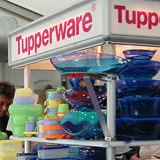 According to The Green Guide, a website and magazine devoted to greener living and owned by the National Geographic Society, the safest plastics for repeated use in storing food are made from high-density polyethylene (HDPE, or plastic #2), low-density polyethylene (LDPE, or plastic #4) and polypropylene (PP, or plastic #5).
According to The Green Guide, a website and magazine devoted to greener living and owned by the National Geographic Society, the safest plastics for repeated use in storing food are made from high-density polyethylene (HDPE, or plastic #2), low-density polyethylene (LDPE, or plastic #4) and polypropylene (PP, or plastic #5).
Most Tupperware products are made of LDPE or PP, and as such are considered safe for repeated use storing food items and cycling through the dishwasher. Most food storage products from Glad, Hefty, Ziploc and Saran also pass The Green Guide’s muster for health safety.
Click here for the rest of the story...
According to the Pediatric Environmental Health Specialty Unit (PEHSU)...
"BPA may cause changes in cells in breasts, the uterus, and the prostate which can increase risk of cancers. In addition, BPA has been associated with increases in developmental disorders of the brain and nervous system in animals. these developmental disorders in animals are like problems such as ADHD (attention deficit hyper-reactivity disorder) in humans."
Click here for the full report...
Is a Chemical in Plastic Bottles a Hazard to Humans? NPR reports...
National Public Radio reported August 9, 2007
That “a chemical called bisphenol A, or BPA, in polycarbonate bottles - may? or may not? - have health effects. Polycarbonate, brand name Lexan®, is used in the most well-known brand of hard plastic water bottles.”
“To be clear: now in question are the very same reusable alternatives to water in disposable plastic bottles? The ones we've been championing for quite some time.”
The NPR report continues, “Also, remember that dishwashers and microwaves breakdown the chemicals in these products further (the reason for the concern about baby bottles, coupled with the knowledge that young ones are most at risk). If they’ve turned hazy, they are especially dangerous because they have already broken down.”
“What more do they need to know? These chemicals are simply used as hardeners and stabilizers of plastics (to increase durability), and we know plastics can be made WITHOUT them!”
Click here for the rest of the story...
Here's a summary of other events from 2007 through 2008...
November 2007
An article in Toxicology Letters (online edition) showed that BPA in polycarbonate bottles are leaching out of the containers into the drinks. The article goes on to say that BPA is an endocrine disrupting chemical (EDC) that mimics the hormone estrogen.
The Environmental Working Group (EWG) has detected BPA in infant formulas. 4 out of the top 5 companies questioned acknowledged using BPA in their packaging.
December 2007
Nalgene polycarbonate bottles were taken off the shelves in Canada.
April 2008
Canada announces its plans to ban BPA-containing bottles.
July 2008
European Food Safety Authority’s AFC Panel declared human BPA exposure is too low to cause any real harm. According to the panel’s report, the human body rapidly metabolises and eliminates BPA out of the body.
September 3, 2008
The NTP reported the following concerns about BPA:
- “some concern” for effects on the brain, behavior, and prostate gland in fetuses, babies, and children at the current levels of exposure.
- “minimal concern” for effects on breast development and early onset of puberty in females
- “negligible concern” that exposure of pregnant women to BPA will result in damage to the unborn child.
- “minimal concern” BPA exposure will cause reproductive effects in workers exposed to higher BPA levels in their place of work but “negligible concern” that to adults exposed to BPA during normal daily activities
September 17, 2008
Researchers at the University of Exeter (UK) reported detecting BPA in the urine of a large portion of a test group of 1455 people. In addition, high levels of BPA in the urine were associated with chronic diseases such as cardiovascular disorders, diabetes, and kidney problems.
October 8, 2008
The University of Cincinnati reports about BPA’s effect on chemotherapy. In the study, BPA seems to mimic estrogen’s action on cancer cells – which is the induction of proteins that can protect the cancer cells from the effects of chemotherapy agents.
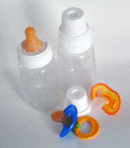 October 10, 2008
October 10, 2008
The American states of Connecticut, New Jersey and Delaware, through their attorney generals officially asked in writing 11 manufacturers to eliminate BPA from milk formula packaging as well from baby bottles.
October 2008
This study demonstrated that when pregnant mice were exposed to low-dose BPA, changes in the neurobehavioral development of the offsprings were observed.
Another study in mice should that BPA exposure during pregnancy altered the cellular structure of the breasts.
October 28, 2008
Based on a review by a subcommittee, the US Food and Drug Administration (US FDA) stated that
“consumers should know that, based on all available evidence, the present consensus among regulatory agencies in the United States, Canada, Europe, and Japan is that current levels of exposure to BPA through food packaging do not pose an immediate health risk to the general population, including infants and babies.”
In addition, the US FDA thinks the Canadian restrictions on BPA are “out of an abundance of caution.”
Although the US FDA tries to reassure the public’s concerns about BPA, concerns about BPA is increasing and this latest findings on chemotherapy resistance “provide considerable support to the accumulating evidence that BPA is hazardous to human health.”